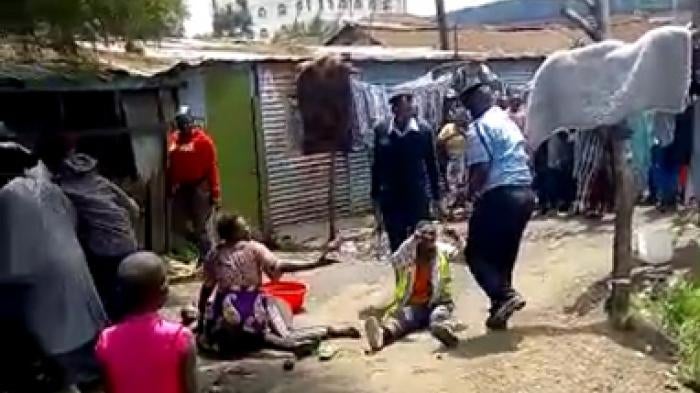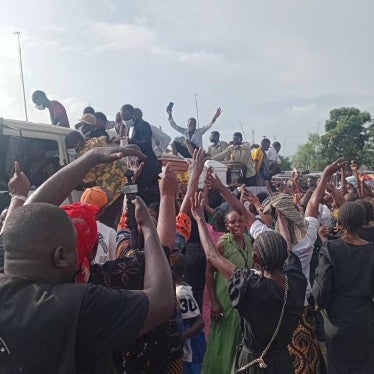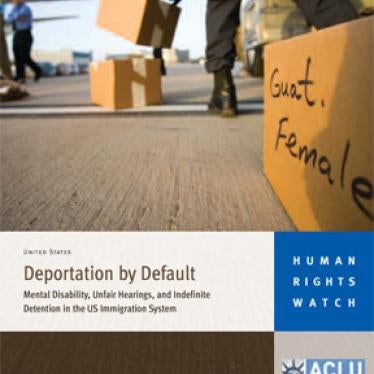(Nairobi) – Since December 25, 2019, police in Kenya have shot dead at least eight people in Nairobi’s Mathare, Kasarani, and Majengo settlements, Human Rights Watch said today. The police continue to kill crime suspects and protesters in cold blood despite persistent calls to end the killings and the use of excessive force.
The killings are the latest in a longstanding pattern of excessive force and unlawful killings in Nairobi’s low-income neighborhoods. Kenyan authorities should urgently investigate all alleged killings, many of which have been documented by Kenyan and international organizations, and ensure that all those responsible are held to account.
“Kenyan police are shooting young people dead in total disregard of the rules for the use of force,” said Otsieno Namwaya, senior Africa researcher at Human Rights Watch. “Kenyan authorities should end these unlawful and unjustified killings of unarmed people and bring officers involved in the killings to justice.”
In January 2020, Human Rights Watch interviewed 23 people including witnesses, family members of victims, hospital mortuary staff, medical and social workers, activists, and police personnel. Human Rights Watch worked closely with partner organizations in Mathare, Majengo, and Kasarani to identify victims and families.
In 3 low-income neighborhoods, police killed at least 8 young men 3 weeks after Christmas, Human Rights Watch found. In Mathare, on December 25 at about 5:30 p.m., police shot dead Peter Irungu, 19, and Brian Mung’aru, 20. Both men were kneeling and pleading with police to spare their lives when they were shot, witnesses said.
On December 26, anti-riot police violently suppressed a protest over the young men’s killings, using live ammunition, tear gas, and beatings. The police beat protesters, injuring more than 10, and arrested many. Police blocked media outlets from accessing Mathare to cover the demonstrations, according to witnesses there.
During a protest on January 15 in the Kasarani settlement over poor road conditions, police fired live bullets at protesters and residents. In the process, they shot dead a 19-year-old transport worker, Stephen Machurusi. Witnesses saw him kneeling to plead with riot police, who had barricaded sections of the road, to allow him to pass through to go to work. A 30-year-old rights activist in Kasarani who witnessed the killing said
“On the way to work, he encountered youth running from police. He didn’t know there was a demonstration. He surrendered to police, raising his hands and said he was on his way to work but one officer just shot him at close range in the chest.”
In Majengo, on January 16, 2 police officers on patrol killed 24-year-old Ahmed Majid. Witnesses said the officers shot him when he tried to intervene as they dragged his friend, Yassin Athuman, 20, along the ground toward the police station. The officers had attempted to plant marijuana on Yassin, which he resisted, after he refused to give them a bribe, the witnesses said.
On January 17, the police killed another four people during street demonstrations by Majengo residents protesting Majid’s killing. A Majengo rights activist who documented the violence said “Police used a lot of force to suppress the demonstrations. They were using live bullets, in most cases just shooting inside people’s houses or aiming at people who were not part of the demonstrations.” Police told the media on January 18 that they have arrested the officer suspected of killing Majid.
The recent killings are the latest in a longstanding pattern of killings and excessive force in these neighborhoods. In July 2019, Human Rights Watch documented 21 cases of police killings of men and boys in Nairobi’s low-income areas of Mathare and Dandora, apparently with no justification, claiming they were criminals. On January 24, 2020, the Independent Policing Oversight Authority (IPOA) said it had recorded an increase in the number of abuses by police, including killings, to 3,200 in 2019 alone. On January 23, 2019, Interior Cabinet Secretary Fred Matiang’i said government would stop reckless shootings and killing of suspects, which he attributed to rogue officers.
Kenyan media have frequently reported killings in low-income neighborhoods. In May 2018, the Standard newspaper reported that police in Nairobi’s Dandora low-income area had killed at least 10 people aged between 18 and 23 in just one week. In October 2018, the Daily Nation reported that police killed at least 101 people in Nairobi and more than 180 people across Kenya in a 9-month period. It was not clear from the media reports whether any of these killings could be considered justified.
Under Kenya’s National Police Service Act of 2011, lethal force is only justified when strictly unavoidable to protect life. Kenyan security forces should also abide by the United Nations Basic Principles on the Use of Force and Firearms by Law Enforcement Officials, which stipulate that law enforcement officials should use nonviolent means and resort to lethal force only when strictly unavoidable to protect life. The basic principles also require governments to ensure that arbitrary or abusive use of force and firearms by law enforcement officials is punished as a criminal offense.
The Police Service Act requires police officers who use lethal fire to report to their immediate superior, explaining the circumstances that necessitated the use of force. Police officers also are required to report for investigation any use of force that leads to death or serious injury to the Independent Policing Oversight Authority (IPOA), a civilian police accountability institution created in 2011 to investigate and prosecute officers implicated in abuses.
In all cases Human Rights Watch documented, the police did not report the killings or initiate the process for an inquest, as required by law. In some cases, the police did not allow victims and their family members to file reports. In at least one case, the police appear to have collected and hid bullet casings instead of waiting for investigators to arrive, as is proper procedure under Kenyan law.
IPOA opened investigations into the killing of the two young men in Mathare on December 25 and Majid’s killing in Majengo on January 16, an IPOA official told Human Rights Watch. There are no ongoing investigations into the other killings. The oversight agency faces many problems in carrying out its work, including lack of cooperation by the police, who often fail to prepare preliminary reports that would identify the officers involved. Despite its efforts, its investigations have only led to six convictions since 2013, when the agency became operational, and it currently has more than 2,000 cases under investigation.
The eight killings since December 25 that Human Rights Watch researchers documented in Nairobi’s low-income areas of Mathare, Majengo, and Kasarani point to a broader pattern of police using excessive, unlawful force in the name of maintaining law and order in Nairobi’s informal settlements.
“Police have an obligation to ensure that all officers comply with the law to investigate all killings and support accountability institutions such as IPOA to ensure those involved in the killings are held to account,” Namwaya said. “The government, starting with President Kenyatta, should ensure that the killings are halted and that those responsible for gunning down unarmed young men are speedily held to account.”
For additional details about the recent killings, please see below.
Mathare Killings
Witnesses in Mathare told Human Rights Watch that around 5:30 p.m. on December 25, four police officers on patrol in civilian clothing picked up four youths outside Good Samaritan Children’s home in Mathare, one of Nairobi’s low-income neighborhoods. A staff member at the home said that the children in the home had just finished Christmas celebrations when the officers picked the youths up outside. Mathare residents said they recognized the four officers as members of the Pangani Six squad. The Pangani Six squad has been implicated in numerous killings of boys and girls in the area, some of which Human Rights Watch documented in July 2019.
The witnesses said that the officers arrested the youths, did a body search, and found no weapons on them. One officer grabbed Brian Mung’aru and Peter Irungu by their shirt collars and led them away, while another three officers walked behind with the other two, Felix Ouma and Daniel Gitau, whom they slapped, punched, and kicked as they interrogated them before releasing them.
The officers took Mung’aru and Irungu to the Amana Petrol station terminus, about a kilometer and a half away from the children’s home, and shot both dead.
A witness, a transport worker working at the matatu (Kenya’s public minibuses) stop near the Amana petrol station, recalled that the officers first accused Irungu of being a criminal. Both men pleaded for their lives.
“The officer shot Irungu on his right arm,” the transport worker said. “Irungu fell into the drainage on the roadside. Mung’aru fainted at the sound of the gunshot.” He said Irungu tried to crawl into the culvert at the entrance to Amana station for safety, but the officer shot him several times in the back, killing him instantly. The officer then turned to Mung’aru, who appeared unconscious, kicked him into the roadside drainage ditch, and shot him several times.
Another witness said that the officers then collected all the bullets and spent cartridges at the scene and that a police vehicle collected the bodies within minutes. He believes this was an attempt to conceal evidence.
A postmortem report by the government pathologist show that Irungu had more than five bullet wounds – one in the stomach, another in the right hand, another in the left jaw, and the others in the back – and that Mung’aru had multiple gunshot wounds in the back, the pelvic area, and the right knee.
The police have not investigated the killings as required by Kenyan law. IPOA has begun an investigation, but the police have not cooperated, including failing to provide a report of preliminary investigations by station commanders.
The police have given a conflicting account of the killings. The Pangani police station records say the two were killed in a violent robbery incident in Mathare, but three days after the killings, the Nairobi county police commander described the incident as “a shootout between police officers and three thugs.”
Kasarani killings
On January 13, in Kasarani, residents and matatu operators commenced peaceful street demonstrations to protest the poor state of roads in the area. On January 15, anti-riot police deployed to the area to suppress the protests beat and kicked people on the streets and shot tear gas and live bullets randomly at protesters and into people’s houses.
A protester who saw the killing said that the police shot dead a 19-year-old transport worker, Stephen Muchurusi, on the street.
“Around 1 p.m., an officer who was firing his gun randomly aimed at Muchurusi, who was kneeling, and shot him in the chest.”
Neither the police nor IPOA have opened investigations into this killing or the police conduct during the demonstrations. Relatives and witnesses to the killing said no one had taken any statements from them.
Majengo killings
Human Rights Watch found that police shot and killed Ahmed Majid, 24, in Majengo at close range apparently because he asked them to either carry his friend Yassin Athuman to the police station or allow him to walk, instead of dragging him. The killing caused minor riots that day. On the day Majid was buried, January 17, there were large street protests, which anti-riot police tried to suppress by firing tear gas and live bullets at people and into houses.
A close friend of Majid who witnessed the killing said that minutes before midday on January 16, Majid ran into 2 police officers less than 10 meters from his house. The officers had arrested Yassin, a motorcycle taxi driver, who was waiting for passengers along a street in Majengo. The officers, said a man who saw the arrest, accused Yassin of being a marijuana smoker, which he denied. The officers then attempted to plant to rolls of marijuana on him. Majid’s relative, who witnessed the shooting, said the officers were dragging Yassin, handcuffed, along the ground.
A 23-year-old woman who witnessed the incident said that Majid tried to intervene but that an officer slapped him down and then shot him in the chest while he was on the ground.
Another witness said that the second officer panicked and uncuffed Yassin, and then both officers ran into a nearby Administration Police camp to escape a crowd that was growing agitated. Friends, including Yassin, rushed Majid to a nearby hospital, where he was pronounced dead.
That afternoon residents held protests, which escalated around lunchtime the next day, after Majid’s burial. An activist in Majengo said “Police used a lot of force to suppress the demonstrations. They also used live bullets, which they were firing into people’s houses.”
The activist said that he documented at least 4 cases of people shot dead by police, 7 cases of people admitted to hospitals with bullet wounds, and 30 cases of people nursing injuries from police beatings. Human Rights Watch was able to confirm the 4 killings.
One of those killed that day was Samuel Chegero Barasa, 35, who, with his family, had locked himself in his house when they saw the police chasing young protesters, firing live bullets and tear gas. A single bullet ripped through the iron sheets that served as the walls of his house and blew his head off, said his wife, Alice Andeso. She told the media that she was with her 3-year-old son when she found her husband’s body lying in a pool of blood in the sitting room. “Where has my father’s head gone to?” she said her son asked. She said her son had not spoken for a week since the killing.
Witnesses who were around Riadha Mosque during the demonstrations described the killing of three other people whose identities were not immediately established. In one case, at about 3 p.m., police shot a street boy who was asleep at a place known as Toilet 34, just outside Riadha Mosque, then carried his body away and removed spent cartridges.
Human Rights Watch located his body at the city mortuary, where it was checked in as “unknown African male shot during violent demonstrations in Majengo.” Mortuary attendants said that the man had an identity card for Victor Omondi Wanyama, but police told the attendants they weren’t sure it belonged to the street boy.
Two men who were inside Riadha Mosque when they saw the killing said that shortly after the police killed the street boy, they killed another man sleeping on the street between Riadha Mosque and Mumbai Mall. The officers quickly carried the body away as others removed spent cartridges. At the city mortuary, the body was also checked in as an “unknown African male shot during violent demonstrations in Majengo.”
Human Rights Watch also saw in the mortuary the body of a fourth person shot during the demonstrations, also checked in as “unidentified African male shot during violent demonstrations in Majengo.” A witness in Majengo’s Rokongo base area said that “the man was running in the open field at Rokongo base when we saw him suddenly fall.” Those who saw him before police carried his body away said the man had been shot in the neck.










